There is nothing better than relaxing beneath a shade tree during the hot months of summer. The dappled light shining through the foliage of large trees is cool and refreshing and adds visual appeal to your home. Easy to grow shade trees not only offer you and your home protection from the sun’s rays, but they provide your yard with a miniature ecosystem that birds and small critters enjoy.
There are many different types of trees scattered throughout North America, and some even gift you with stunning fall foliage before releasing their leaves in the fall.
Shade trees are a perfect way to bring nature to your home, and you don’t have to wait for Arbor Day to plant them.

- Fast-Growing Shade Trees for the Yard
- What are the Benefits of a Shade Tree?
- Which Trees are Best for Shade?
- Where Can I Plant Shade Trees?
- How Do I Plant a Shade Tree?
- Silver Maple (Acer saccharinum)
- Red Maple (Acer rubrum) – Easy to Grow Shade Trees with Stunning Foliage
- Pin Oak (Quercus palustris)
- Weeping Willow (Salix babylonica) – Whimsical and Elegant Shade Tree
- Northern Red Oak (Quercus rubra)
- Magnolia (Magnolia grandiflora) – Flowering Tree for Shade
- Birch (Betula nigra)
- Dogwood (Cornus) – Shade Tree with Three Season Interest
- Hybrid Poplar (Populus alba)
- Tulip Poplar (Liriodendron tulipifera) – Flowering Tree with Colorful Fall Foliage
- Dawn Redwood (Metasequoia glyptostroboides)
- Pecan (Carya illinoinensis) – Shade Tree with Edible Nuts
- Paulownia (Paulownia tomentosa)
- American Sycamore (Platanus occidentalis) – Fast Growing Trees with Distinctive Bark
Fast-Growing Shade Trees for the Yard
Just like with easy to grow flowering bushes, trees come in so many different varieties that it is hard to decide which one is the right one for your yard. Some are tall and upright, while others have a widespread canopy.
Some produce spring flowers in the spring, while others are a favorite for their bright fall color. It is essential to choose the right one for your area and home space before planting it into the ground.
Whether you are considering some fast growing spruce trees or specimens with a dramatic canopy, we have some excellent ideas for you.
What are the Benefits of a Shade Tree?
The main reason for planting shade trees around your property is to provide your yard and home with shelter from the sun during the summer months. These types of trees help cut cooling costs for your home. Not only do they help protect you from too much sunshine, but they provide relief from rain and wind.
Shade trees also benefit the wildlife around your house. They draw in many different species of birds, squirrels, and other critters and provide them with food and shelter.
Which Trees are Best for Shade?
There is an almost endless list of fast growing shade trees, but some are better for shade than others. Trees that are large and have a spreading canopy and crown are ideal for use as a shade tree. You can also consider evergreen privacy trees for relief from the hot sun.
The first tree to come to mind when thinking about shade is the oak tree, and luckily there are many varieties, from the northern red oak to the sawtooth oak.
There are also flowering trees that provide shade from the sun, including flowering dogwood and magnolia. If fall color is your thing, consider the red or sugar maple tree.

Where Can I Plant Shade Trees?
To maximize the sun protection of your shade tree, consider planting it on the eastern, western, or southern side of your yard. Inspect the area and choose a spot that accommodates the mature size of your tree. While the tree seems small after planting it, in five or ten years, that tree grows to a height that takes over an entire section of your yard.
Not only is it important to know the growth rate of your tree, but understanding which trees grow best for your area of the United States is also vital. Check the USDA hardiness zones listed for the tree.
For extra benefit, after your shade trees become established, grow a shade vegetable garden or one for shade flowers. Take advantage of the darker space to add fresh produce to your kitchen.
If you aren’t interested in growing your own veggies, there are many pretty shade plants to choose from, as well. Lily of the valley and coral bells both enjoy fewer rays of sunlight.
Add a few shrubs for a shade garden to complement a patio or deck and add a little privacy without sacrificing your view.
How Do I Plant a Shade Tree?
If possible, plant trees during the dormant season. Before planting in your yard, make sure that there are no utility lines, cables, or septic systems in the vicinity. Dig a hole that is up to three times wider than the root ball, but no deeper.
Remove the tree from the container or sack and place it into the hole. Make sure to keep it straight while backfilling the hole with dirt.
Stake the tree to help it develop a more robust trunk. Make sure to spread mulch around the base of the tree to moderate soil temperature and retain moisture. Water it once a week, with extra watering during hot or windy periods.
Silver Maple (Acer saccharinum)

This tree has a v-shaped growth habit with foliage that has a shimmering appearance. The early spring blooms of the silver maple are beneficial to pollinators. Critters such as finches, squirrels, and chipmunks eat the seeds, and deer and rabbits enjoy the leaves.
Silver maples grow 2 feet or more per year and reach a mature height of 50 to 80 feet tall with a canopy of 35 to 55 feet. It is hardy in zones 3 through 9 and is moderately drought tolerant.
Red Maple (Acer rubrum) – Easy to Grow Shade Trees with Stunning Foliage
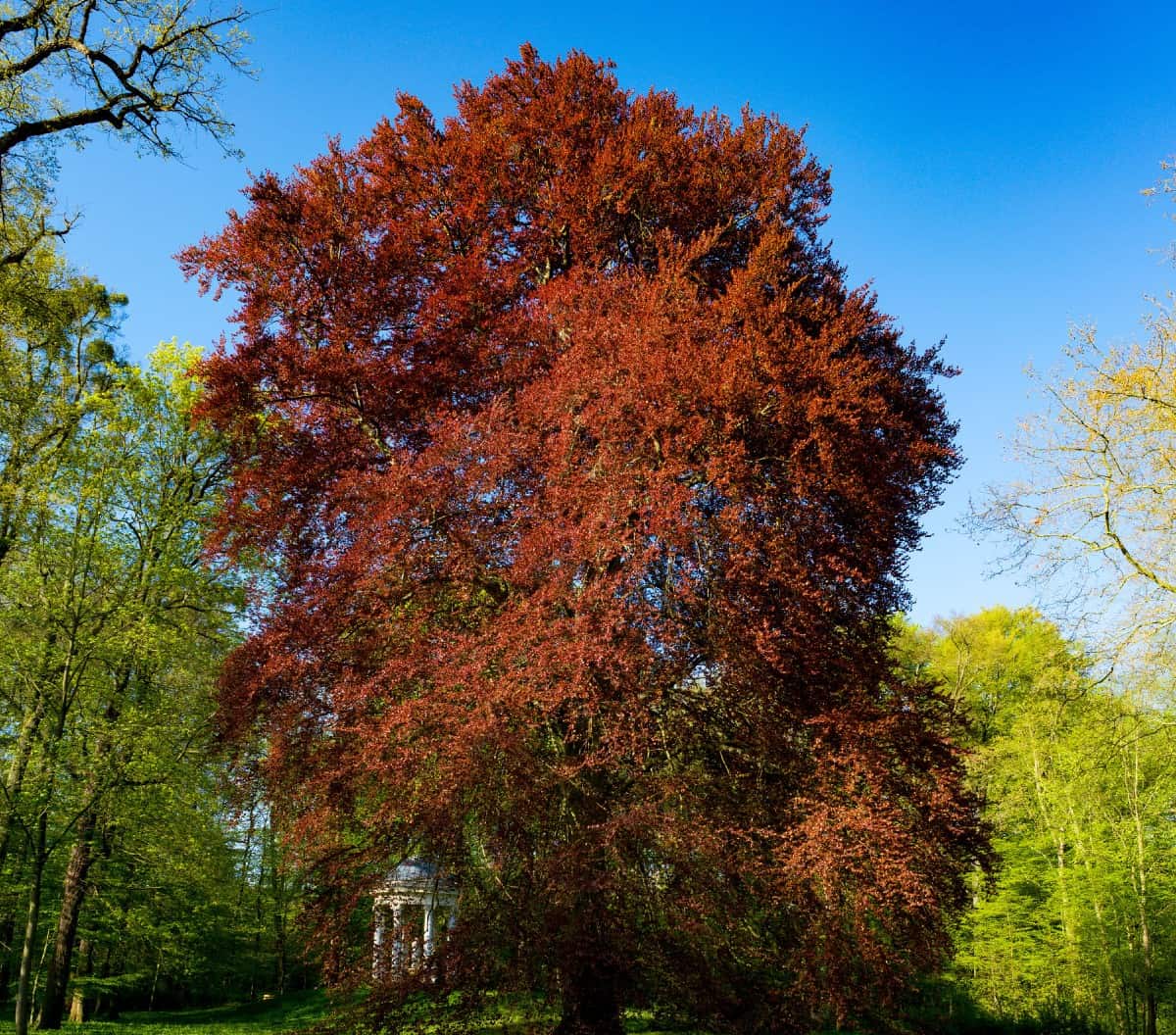
The red maple is a prevalent tree in the eastern United States and is easy to spot in urban landscapes. It fills the yard with autumn blaze with its bright red and sometimes orange or yellow foliage. These trees for fall foliage produce small red flowers from March through May, followed by reddish helicopter fruit-seed pods.
Red maple trees reach a mature height of 40 to 70 feet with a canopy spread of 30 to 50 feet. This maple thrives in full to partial sun exposure and adapts to most soil types.
Pin Oak (Quercus palustris)

While many oak trees are known for their massive and gnarled aspect, the pin oak has a straight and graceful appearance with slender, pin-like twigs and is one of the ideal trees for shade. Its unique shaped leaves are dark green during the summer months and turn to dull scarlet in the fall.
The pin oak grows up to 3 feet a year and reaches a mature height of 70 feet or more. Native to the eastern United States, it thrives in zones 4 through 8 and has a long lifespan.
Weeping Willow (Salix babylonica) – Whimsical and Elegant Shade Tree
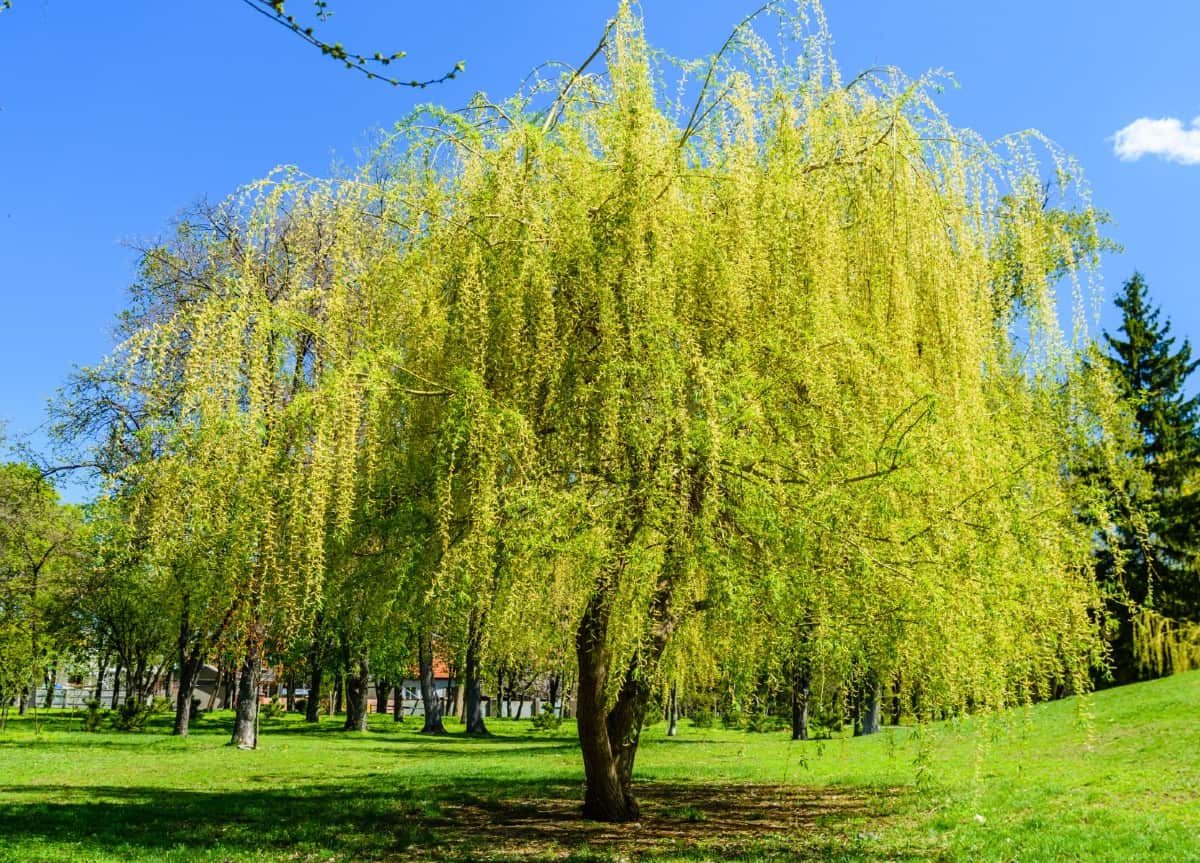
These whimsical easy trees have long, pendulous branches that droop like natural lengths of rope. The foliage is small in shape and blue/green during the summer, turning a stunning shade of yellow in the fall. It not only provides shade during the summer but is also suitable for backyard privacy.
The weeping willow reaches a mature height of 20 feet or more and spreads up to 40 feet. It thrives in hardiness zones 6 through 8 and prefers sunny locations.
Northern Red Oak (Quercus rubra)

This adaptable tree has a handsome appearance and is an excellent choice for summer shade in the midwest. Under the right conditions, the red oak produces dark red foliage during the later fall months.
The Northern red oak is suitable for growing in zones 3 through 8 and prefers at least six hours of direct sunlight daily. It reaches a mature height 60 to 75 feet with a spread of 45 to 50 feet.
Magnolia (Magnolia grandiflora) – Flowering Tree for Shade

Magnolia trees usher in spring with their wonderfully fragrant showy blooms in shades of purple, pink, yellow, and white flowers. The flowers are followed by evergreen blue/green foliage with copper-colored, fuzzy undersides.
This tree is not only useful for shade during the summer months but is an excellent choice for slope/erosion control. These flowering trees for small spaces or large areas reach a mature height and spread of 20 feet or more. Magnolia trees grow best in hardiness zones 5 through 9.
Birch (Betula nigra)
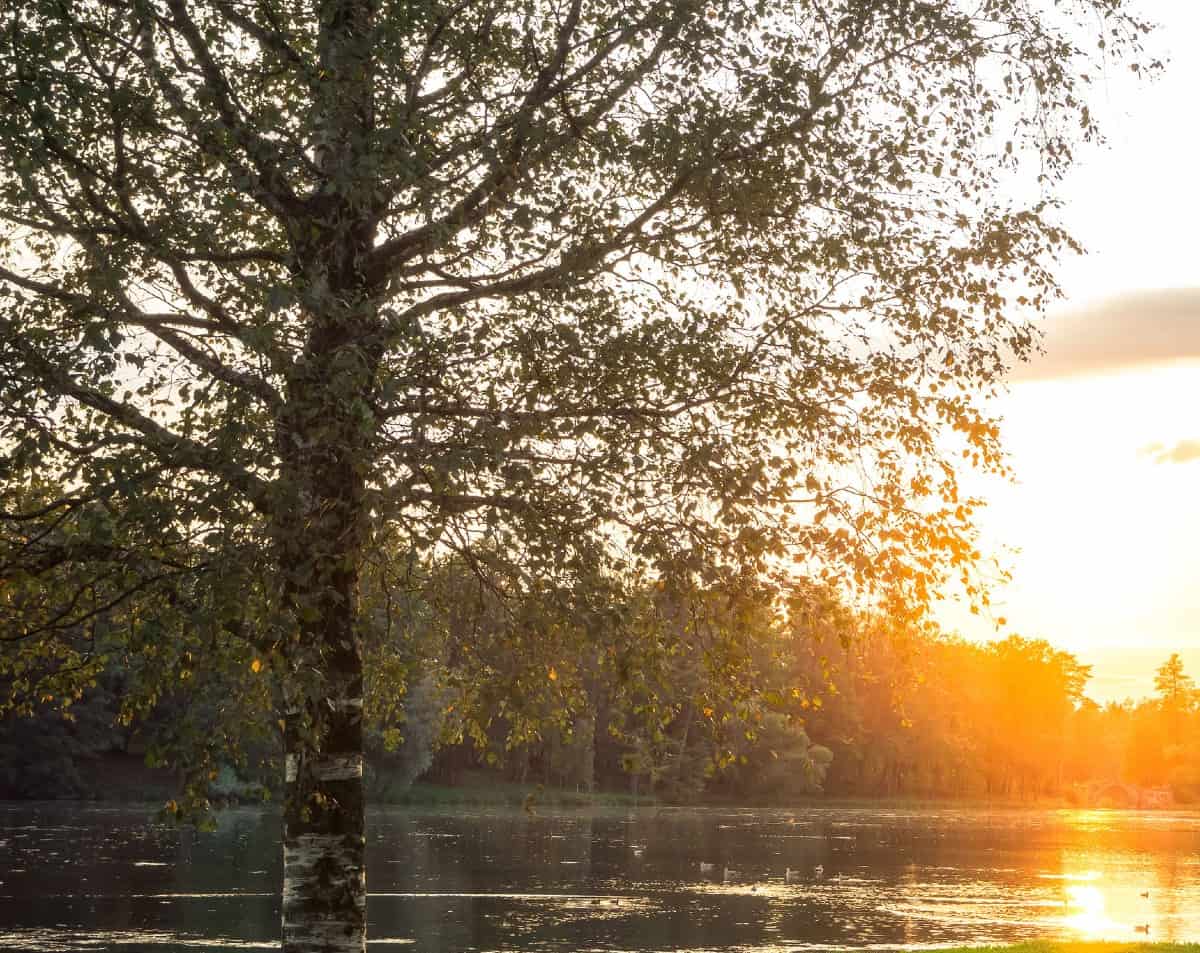
Birch trees are a medium to large tree that comes in many varieties, including the river birch, silver birch, and paper birch. They thrive in moist, well-drained soil and provide a welcome habitat for many wildlife.
These trees have colorful fall foliage and grow best in a moderate climate in zones 2 through 7. They reach a mature height of 20 feet or more with a canopy spread of 15 to 25 feet.
Dogwood (Cornus) – Shade Tree with Three Season Interest
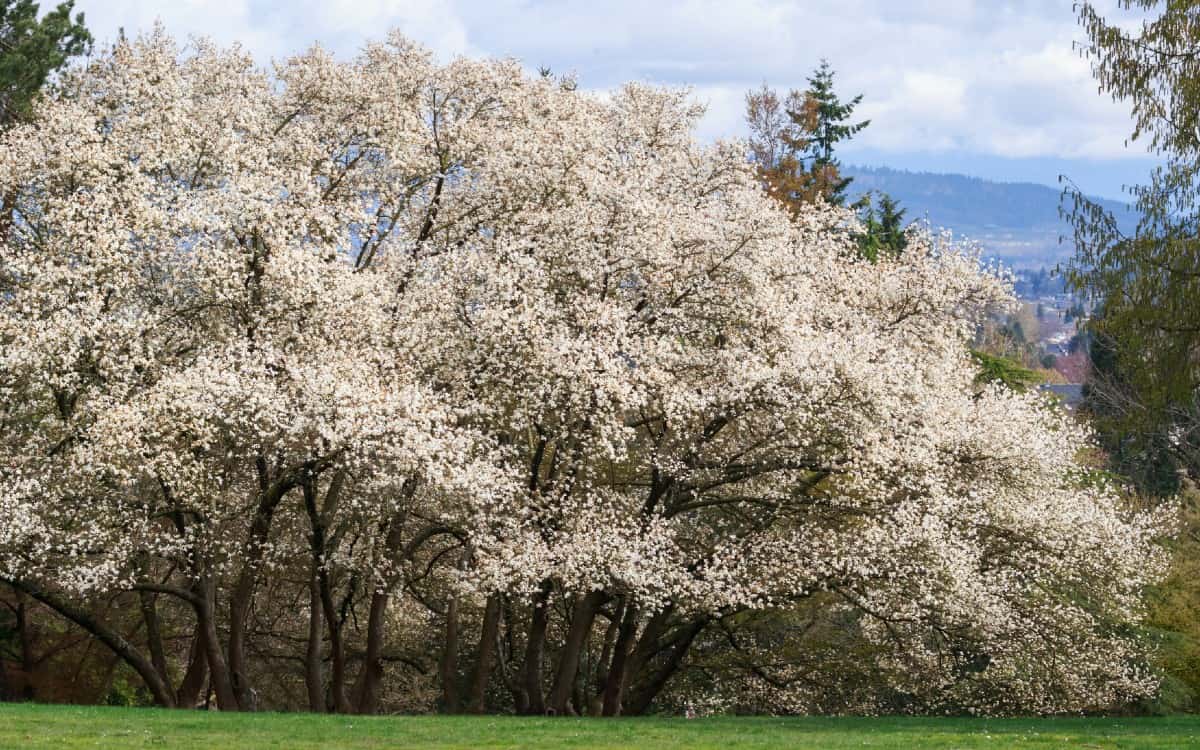
Three season dogwood trees come in a variety of shapes, colors, and sizes, providing interest to the yard in stages. During the springtime, this tree produces four-petal flowers that continue blooming through the summer. It gives way to bright red and orange foliage during the fall, followed by red fruit in the winter.
This low maintenance shade tree thrives in zones 3 through 8 and grows best in partial to full sun. It has a mature height of 20 feet or more with a spread of 10 to 15 feet.
Hybrid Poplar (Populus alba)
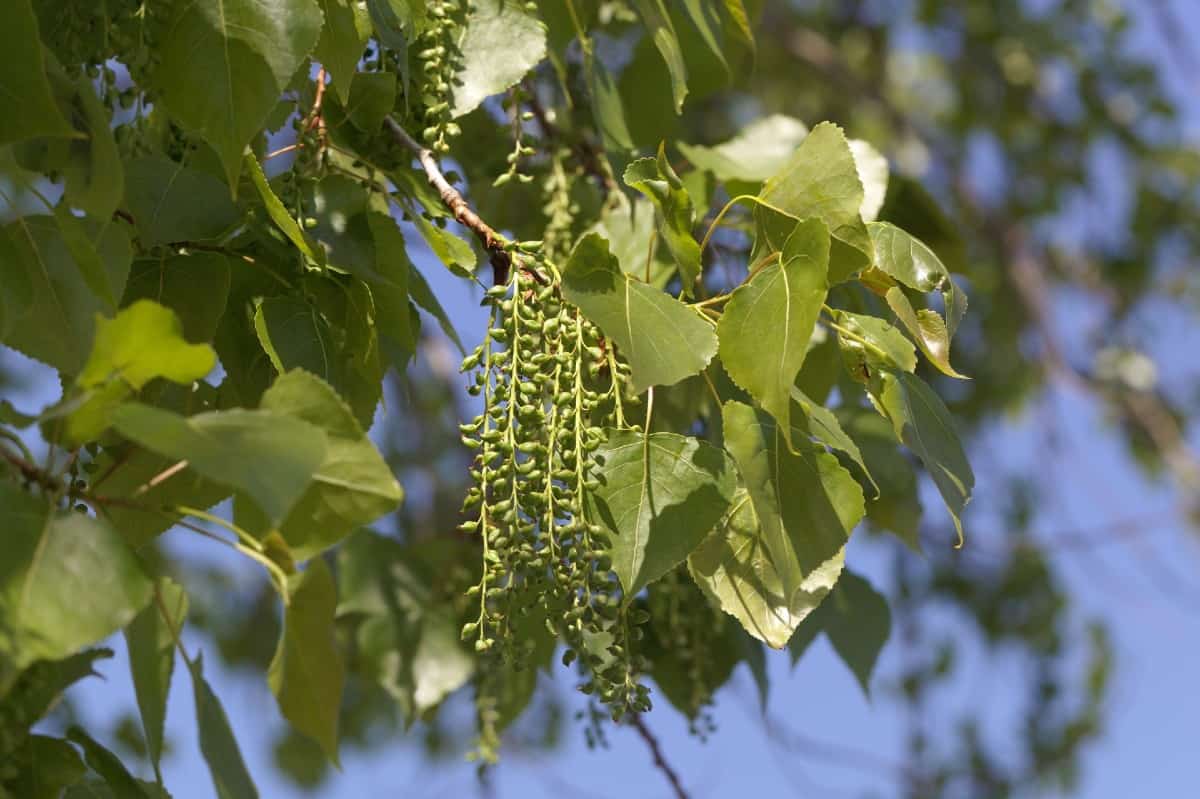
There are many varieties of poplar trees, including the white poplar, and they all belong to the willow family. The hybrid poplar is a fast-growing tree that grows 5 to 8 feet per year. This cottonless hybrid is a broad-shaped tree with silvery-green, triangular-shaped leaves.
It has a mature height of 40 to 50 feet with a spread of 30 feet. Rodents, rabbits, deer, and other wildlife enjoy the bark and twigs.
If you don’t want the wildlife nibbling on your poplars, add a few deer resistant bushes around them to keep them away.
Tulip Poplar (Liriodendron tulipifera) – Flowering Tree with Colorful Fall Foliage

The tulip tree has a tall, straight trunk with discreet flowers shaped like tulips during the springtime. The flowers rest beside the unique leaves and bloom in shades of green, orange, and yellow.
This low maintenance tree reaches a mature height of 20 feet or more with a spread of 30 to 50 feet. The tulip tree thrives in hardiness zones 4 through 9 and prefers full sun. It has a shallow root system and requires well-drained soil.
Dawn Redwood (Metasequoia glyptostroboides)
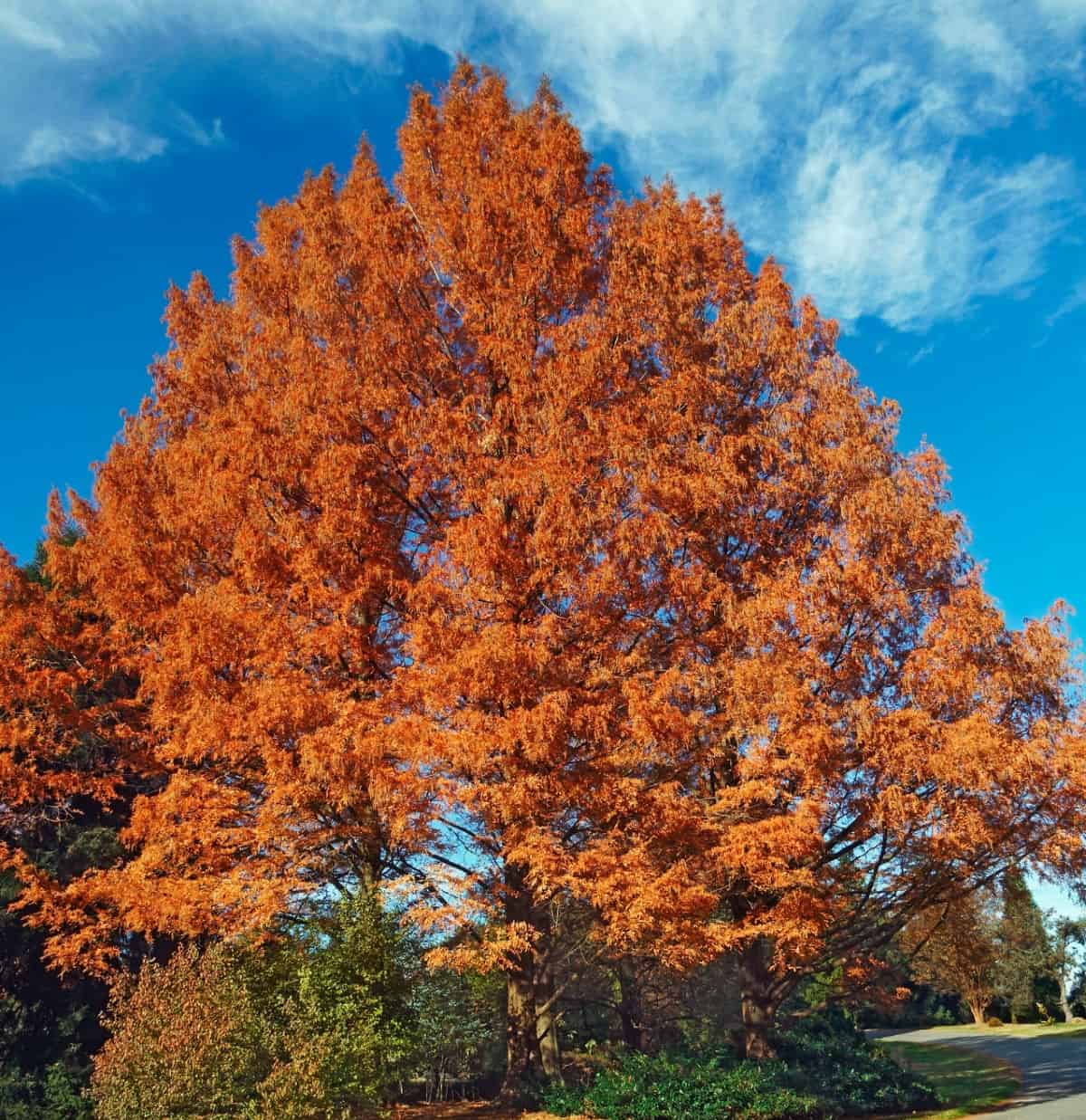
While the dawn redwood is a deciduous tree, it resembles an evergreen during the summer. The foliage is blue/green and chartreuse/gold that turns to a russet-red color during the fall.
This fast growing tree reaches a mature height of 20 feet or more with a spread of 20 to 40 feet, and its growth rate makes it ideal for providing quick shade. It is low maintenance and thrives in sunny locations in zones 5 through 8.
Pecan (Carya illinoinensis) – Shade Tree with Edible Nuts

Pecan trees have massive trunks with rounded spreading crowns of branches. They bear sweet nuts in abundance approximately six to ten years after planting, making them not only ideal as a shade tree but a crop tree as well.
These trees grow in zones 6 through 9 and prefer full sun. They have a mature height of 70 to 100 feet and a spread of 40 to 75 feet, so a lot of space is necessary for proper growth. They have a medium growth rate.
Paulownia (Paulownia tomentosa)
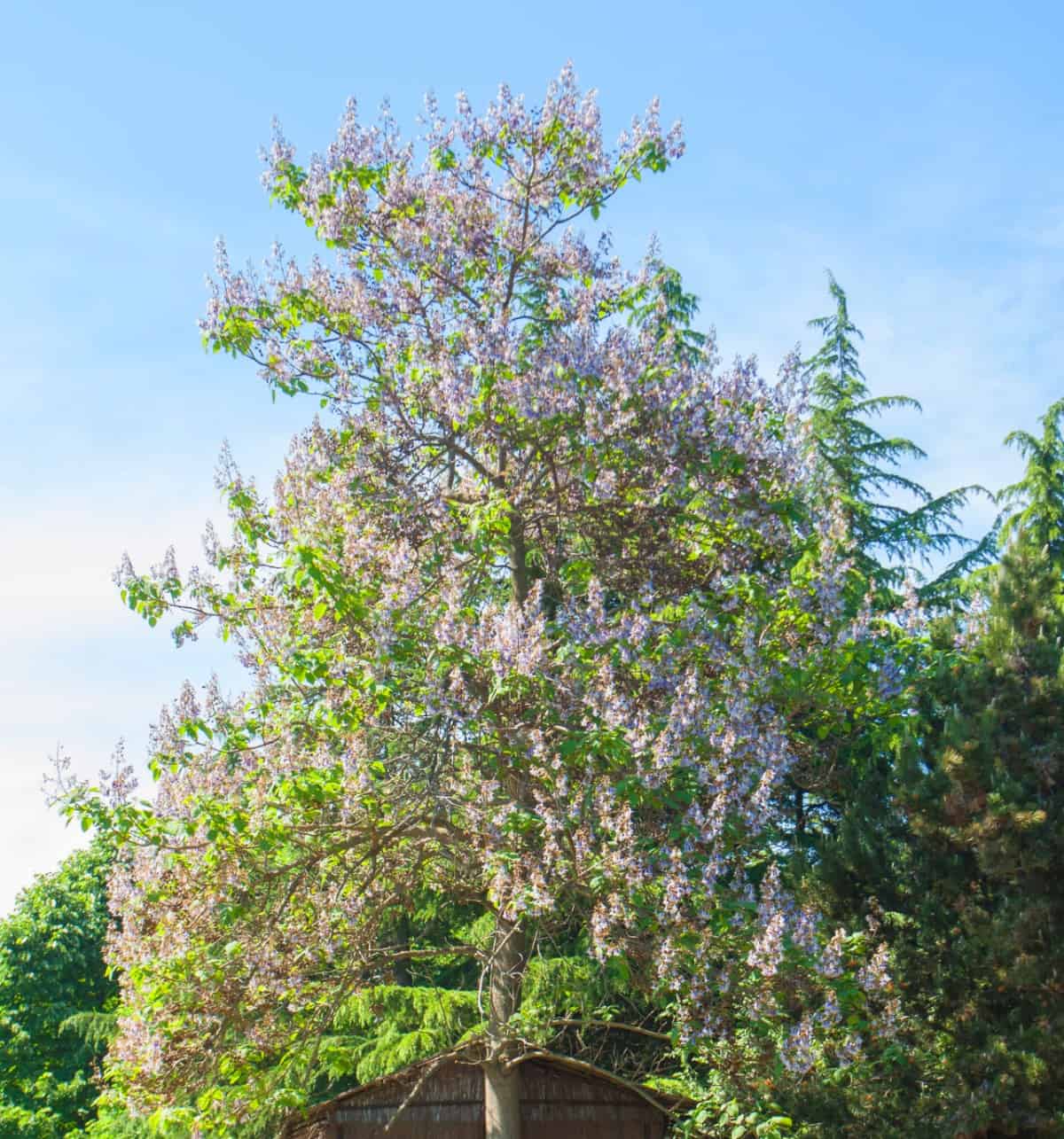
This easy-to-grow tree is a fast grower and grows up to 3 feet per year. It is commonly referred to as the princess or empress tree and produces 14-inch panicles of trumpet-shaped pink and lavender flowers with a vanilla fragrance.
The paulownia tree has large, heart-shaped, deep green leaves and reaches a mature height and spread of 30 to 40 feet. It thrives in zones 6 through 9.
American Sycamore (Platanus occidentalis) – Fast Growing Trees with Distinctive Bark

This well-behaved and fast growing shade tree provides winter interest to the yard with its unique bark and spurred seed balls. It attracts birds and is an excellent tree for privacy and slope/erosion control.
The American sycamore grows best in zones 5 through 9. It prefers part to full sun and tolerates drought and air pollution. It has a mature height of 20 feet or more with a spread of up to 70 feet wide.
Growing the right trees in your yard is a win-win situation for both you and nature. You provide the TLC the young tree requires, and in return, it gives you beauty and shade while offering up its branches as shelter to the local wildlife. With all of the benefits that shade trees provide to you, your home, and the environment, how can you go wrong?

We hope that you benefit from planting one of these easy to grow shade trees in your yard, and we’d love it if you’d share our shade tree guide with your family and friends on Facebook and Pinterest.